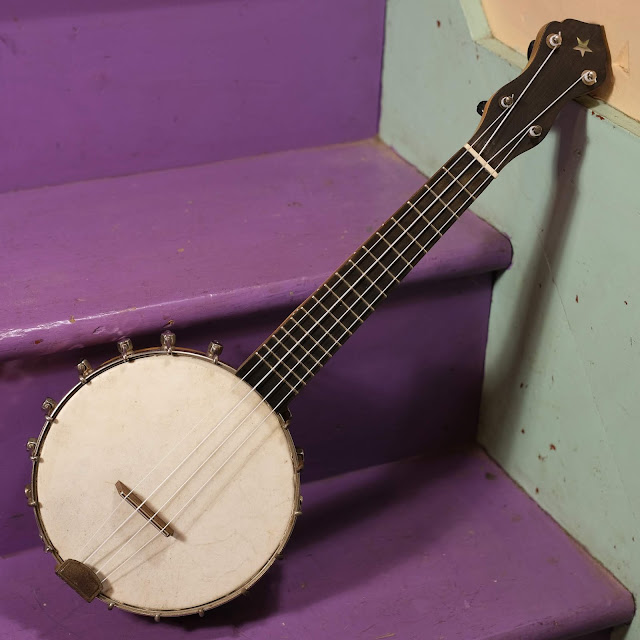1920s Slingerland-style The Vernon Banjo Ukulele
So many! I've worked on so many variations of this same basic model. This one's earlier (probably early '20s) and sports "The Vernon" branding rather than the more usual branding I see on these -- Slingerland, MayBell, or Concertone. Sometimes one sees these under the Bruno name, too. My recent suspicion is that they were made in the New York Lange factory as they have lots of similarities to the lower/mid-grade "Lange Make" and "Banner Blue" products built at the same time.
This version of the same basic mold has no tonering, a thin pearwood (or maybe ebonized maple) fretboard, thicker/rounder neck profile, and the earlier, shorter scale length. It has a mellow, plunky, old-timey tone that suits fingerpicking and relaxed strumming just fine.
Repairs included: a fret level/dress, side dots install, new skin head (using salvaged vintage skin), new rosewood bridge with "fret saddle" topper, new bone nut, cleaning, a few replacement parts (a few hooks, nuts, and one "shoe" for the rim), and setup.
Setup notes: it plays perfectly with 1/16" action at the 12th fret and a straight neck. Strings are Aquila Nylgut.
Scale length: 13"
Nut width: 1 3/16"
String spacing at nut: 15/16"
String spacing at bridge: 1 5/16"
Head diameter: 7"
Rim depth: 2 1/4"
Rim material: ply maple w/maple veneer
Neck wood: poplar
Fretboard: ebonized maple or pearwood
Bridge: new rosewood w/fret saddle
Neck feel: medium-bigger C-shape, flat board
Condition notes: minor wear and tear throughout with some water discoloration to the finish on the back of the neck (a sweaty player in summer, maybe?). Average wear for the time, though. Note above replaced parts -- though all replacement parts are period. The friction tuners at the headstock are original and work OK, but I would be more than happy (and your brain would be happier) to install an upgrade set of GraphTech Tune-A-Lele pegs or Gotoh UPT pegs at cost.
Someone moved "The Vernon" tag from the front of the headstock to the rear of the heel at some point.
Note that the neck joint on this always used a simple screw-on reinforcement attachment. I like that best with a "doweled" banjo, anyway. It's stable. I drilled the mount a little longer, though, and put in a coarser drywall screw in place of the small original. This is even more stable. Note that I did have to shim-up the neck joint a little bit to get the angle correct for the 5/8" bridge height.
















Comments